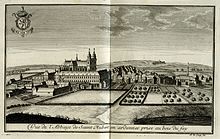Abbaye de St-Pierre en Ardennes | |
 | |
| Monastery information | |
|---|---|
| Order | Order of St Benedict |
| Established | 687 |
| Disestablished | 1797 |
| Diocese | Liège |
| Site | |
| Coordinates | 50°01′35″N 5°22′28″E / 50.0265°N 5.3744°E |
Saint-Hubert Abbey ( French: Abbaye de Saint-Hubert), officially the Abbey of St Peter in the Ardennes (Abbaye de Saint-Pierre en Ardennes), was a Benedictine monastery founded in the Ardennes in 687 and suppressed in 1797. The former abbey church is now a minor basilica in the diocese of Namur, Belgium. It was listed as built heritage in 1938, and as an exceptional monument in 2016. [1]
History

The monastery was founded in the village of Andage in 687 by Pepin of Herstal and his wife, Plectrude, for the monk Bergis. It was dedicated to St Peter. [2]
The remains of St Hubert (died 727) were installed in the monastery on 30 September 825. Both the abbey and the town would as a result come to be generally known as " Saint-Hubert".
Because of St Hubert's status as patron saint of hunting, the Abbey was a noted centre of hound breeding and today's Bloodhound is believed to be descended from the hounds bred there. [3]
There were serious fires in the monastery in 1130, 1261, and 1525, and the building was sacked by Calvinists in 1568. [4] The final suppression of the monastery took place in 1797.
Chronicle
The monastery's chronicle, known as the Cantatorium of Saint-Hubert from the music book in which it was originally recorded, was published in 1906 in an edition by Karl Hanquet. [5] Originally composed in the years around 1100, it is a major source for the history of the investiture controversy in the diocese of Liège. [6]
References
- ^ Belgisch Staatsblad / Moniteur Belge, 2016/205312. Accessed 30 January 2017.
- ^ J. Dury and J.-P. Delville, "Liège, 2: L’expansion généralisée du christianisme (viie siècle)", in Dictionnaire d'histoire et de géographie ecclésiastiques, vol. 32 (Turnhout: Brepols Publishers, 2015), 150-151.
- ^ Jardine-Buchanan J. (1937), Hounds of the World.
- ^ P. Bertrand, "Hubert (Saint)", in Dictionnaire d'histoire et de géographie ecclésiastiques, vol. 25 (Paris: Letouzey et Ané, 1995), 23-24
- ^ Karl Hanquet (ed.), La Chronique de Saint-Hubert dite Cantatorium (Hayez, Imprimeur de L'Academie, Bruxelles, 1906)
- ^ Arnoud-Jan A. Bijsterveld, "Patrons and Gifts in Eleventh- and Twelfth-Century Chronicles from the Diocese of Liège: An Introduction", in The Medieval Chronicle: Proceedings of the 1st International Conference on the Medieval Chronicle, edited by Erik Kooper (Amsterdam, Rodopi, 1999), pp. 69-83.
Abbaye de St-Pierre en Ardennes | |
 | |
| Monastery information | |
|---|---|
| Order | Order of St Benedict |
| Established | 687 |
| Disestablished | 1797 |
| Diocese | Liège |
| Site | |
| Coordinates | 50°01′35″N 5°22′28″E / 50.0265°N 5.3744°E |
Saint-Hubert Abbey ( French: Abbaye de Saint-Hubert), officially the Abbey of St Peter in the Ardennes (Abbaye de Saint-Pierre en Ardennes), was a Benedictine monastery founded in the Ardennes in 687 and suppressed in 1797. The former abbey church is now a minor basilica in the diocese of Namur, Belgium. It was listed as built heritage in 1938, and as an exceptional monument in 2016. [1]
History

The monastery was founded in the village of Andage in 687 by Pepin of Herstal and his wife, Plectrude, for the monk Bergis. It was dedicated to St Peter. [2]
The remains of St Hubert (died 727) were installed in the monastery on 30 September 825. Both the abbey and the town would as a result come to be generally known as " Saint-Hubert".
Because of St Hubert's status as patron saint of hunting, the Abbey was a noted centre of hound breeding and today's Bloodhound is believed to be descended from the hounds bred there. [3]
There were serious fires in the monastery in 1130, 1261, and 1525, and the building was sacked by Calvinists in 1568. [4] The final suppression of the monastery took place in 1797.
Chronicle
The monastery's chronicle, known as the Cantatorium of Saint-Hubert from the music book in which it was originally recorded, was published in 1906 in an edition by Karl Hanquet. [5] Originally composed in the years around 1100, it is a major source for the history of the investiture controversy in the diocese of Liège. [6]
References
- ^ Belgisch Staatsblad / Moniteur Belge, 2016/205312. Accessed 30 January 2017.
- ^ J. Dury and J.-P. Delville, "Liège, 2: L’expansion généralisée du christianisme (viie siècle)", in Dictionnaire d'histoire et de géographie ecclésiastiques, vol. 32 (Turnhout: Brepols Publishers, 2015), 150-151.
- ^ Jardine-Buchanan J. (1937), Hounds of the World.
- ^ P. Bertrand, "Hubert (Saint)", in Dictionnaire d'histoire et de géographie ecclésiastiques, vol. 25 (Paris: Letouzey et Ané, 1995), 23-24
- ^ Karl Hanquet (ed.), La Chronique de Saint-Hubert dite Cantatorium (Hayez, Imprimeur de L'Academie, Bruxelles, 1906)
- ^ Arnoud-Jan A. Bijsterveld, "Patrons and Gifts in Eleventh- and Twelfth-Century Chronicles from the Diocese of Liège: An Introduction", in The Medieval Chronicle: Proceedings of the 1st International Conference on the Medieval Chronicle, edited by Erik Kooper (Amsterdam, Rodopi, 1999), pp. 69-83.